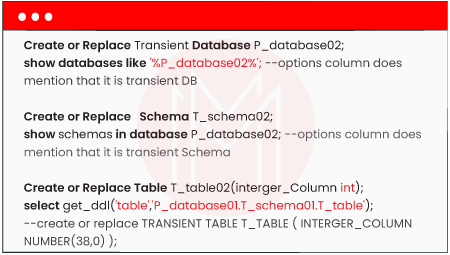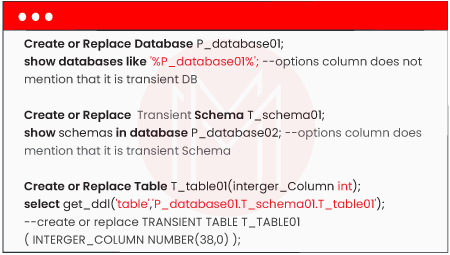- Snowflake Interview Questions and Answers
- Snowflake Tutorial
- Snowflake Architecture
- What is Snowflake Data Warehouse
- Star schema and Snowflake schema in QlikView
- Snowflake vs Redshift - Which is the Best Data Warehousing Tool
- Snowflake vs BigQuery
- Snowflake Time Travel - A Detailed Guide
- Snowflake vs Databricks
- Snowflake vs Azure
- Snowflake Vs Hadoop: What's the Difference?
- How to Insert Data in Snowflake
- Snowflake Connectors
- Snowflake Documentation - A Complete Guide
- How to Update Data in Snowflake?
- How to Delete Data in Snowflake
- How to Add a Default Value to a Column in Snowflake
- How to Add a Column in Snowflake
- How to Add a NOT NULL Constraint in Snowflake
- How to Alter a Sequence in Snowflake
- How to Create a Table in Snowflake
- How to Create a View in Snowflake
- How to create an Index in Snowflake
- How to Drop a Column in Snowflake
- How to Drop a Table in Snowflake
- How to Drop a View in Snowflake?
- How to Drop the Index in Snowflake
- How to Duplicate a Table in Snowflake
- How to Remove a NOT NULL Constraint in Snowflake
- How to Remove a Default Value to a Column in Snowflake
- How to Rename a Table in Snowflake
- How to Rename a Column in Snowflake
- How to write a Common Table Expression(CTE) in Snowflake
- How to Write a Case Statement in Snowflake
- How to Use Coalesce in Snowflake
- How to Query a JSON Object in Snowflake
- How to Truncate a Table in Snowflake
- How to Group by Time in Snowflake
- How to Import a CSV in Snowflake
- How to Query Date and Time in Snowflake
- How to Convert UTC to Local Time Zone in Snowflake
- How to Avoid Gaps in Data in Snowflake
- How to Have Multiple Counts in Snowflake
- How do we Calculate the Running Total or Cumulative Sum in Snowflake
- How to Round Timestamps in Snowflake
- How to Calculate Percentiles in Snowflake
- How to Compare Two Values When One Value is Null in Snowflake
- How to do Type Casting in Snowflake
- How to Get First Row Per Group in Snowflake
- Snowflake Cloning - Zero Copy Clone
- Snowflake Competitors and Comparisons
- Snowflake Integrations
- Snowflake Key Features
- Snowflake Tables and View Management
- Snowflake Advanced Querying & Analytics
- Snowflake SQL Functions & Conditionals
- Snowflake DML and Constraint Operations
Snowflake has emerged as one of the most reliable platforms for cloud data warehousing. It offers cloud-based data storage or data-warehouse-as-a-service and analytics service more flexible than traditional offerings. According to Forrester’s ‘Total Economic Impact Study,’ Snowflake customers can expect an ROI of 612% and total benefits of over $21 million over three years.
This blog post describes what the Snowflake table is, the types of tables in Snowflake, and compares table types.
What is a table in Snowflake?
A snowflake schema is a logical grouping of tables in a multidimensional database during computing such that the entity-relationship plan relates a snowflake shape. Snowflake is a method of normalizing the table’s dimension in a star schema. The principle behind Snowflaking is the normalization of the dimension tables by eliminating the low cardinality attributes.
All data in Snowflake is stored in database tables and logically structured as collections of rows and columns. To get the maximum benefit of Snowflake tables, it’s better to understand the physical structure behind the logical structure, especially on large tables.
Snowflake consists of schemas, which are logical groupings of database objects, such as views and tables. Snowflake does not place any limit on the number of databases, schemas, or things.
What are the types of tables in Snowflake?
What are the types of tables in Snowflake?
Snowflake offers three types of tables, namely - Transient, Temporary, & Permanent.
The permanent table is the default type in Snowflake.
#1. Temporary Tables:
Snowflake supports creating temporary tables to store transient, non-permanent data.
Temporary tables exist only within the session. They are created and persist only for the session remainder. They are not visible to other sessions or users and don’t support standard features like cloning.
Therefore the data stored in the system is cleaned entirely and is not recoverable either by the user-created table or Snowflake.
To create a temporary table, specify the TEMPORARY keyword in CREATE TABLE.

#2. Transient Tables:
Snowflake supports creating Transient tables that continue until dropped explicitly and are available to all the users with the relevant privileges.
To maintain transitory data beyond each session, transient tables are designed. Temporary tables are similar to permanent tables with the vital difference in their absence of a Fail-safe period.
To create a temporary table:
After creation, transient tables cannot be converted to another table type.
#3. Permanent Tables:
Permanent tables have a Fail-safe period similar to transient tables and provide additional security of data recovery and protection.
Presently, the permanent table cannot be modified to Transient Table using ALTER TABLE command. Property of TRANSIENT is set at the creation of a table and cannot be customized.
In the same way, it isn’t possible to change directly a transient table to a permanent table.
In order to convert an existing transient table to a permanent table (or vice versa) through protecting data and other characteristics such as granted privileges and column defaults, you can create a new table and use the COPY GRANTS clause, then copy the data.
Let’s understand with a few examples.
Example 1) Create a transient database to acquire all create schema/tables as transient by default.

Example 2) Create a permanent database with Transient schema to acquire all create tables as transient by default.


Comparison of Table Types
The following table summarizes the differences between the three data types with regard to Time travel and fail-safe.

Conclusion:
In this article, you have learned about the Snowflake table, the types of tables, and their comparison. We hope you got a clear idea of Snowflake tables. To know more read our Snowflake Tutorial.
Thanks for reading this article so far. If you find this blog useful then please share it with your friends and colleagues. If you have any questions or feedback then please drop it in the comment section below.
Related Articles:
 On-Job Support Service
On-Job Support Service
Online Work Support for your on-job roles.

Our work-support plans provide precise options as per your project tasks. Whether you are a newbie or an experienced professional seeking assistance in completing project tasks, we are here with the following plans to meet your custom needs:
- Pay Per Hour
- Pay Per Week
- Monthly
| Name | Dates | |
|---|---|---|
| Snowflake Online Training and Certification Course | Jan 06 to Jan 21 | View Details |
| Snowflake Online Training and Certification Course | Jan 10 to Jan 25 | View Details |
| Snowflake Online Training and Certification Course | Jan 13 to Jan 28 | View Details |
| Snowflake Online Training and Certification Course | Jan 17 to Feb 01 | View Details |

Madhuri is a Senior Content Creator at MindMajix. She has written about a range of different topics on various technologies, which include, Splunk, Tensorflow, Selenium, and CEH. She spends most of her time researching on technology, and startups. Connect with her via LinkedIn and Twitter .











